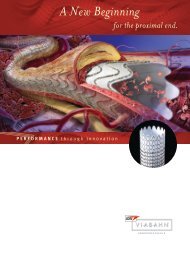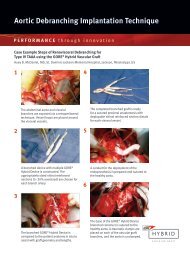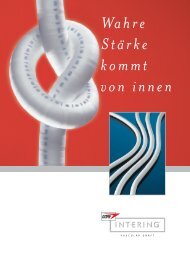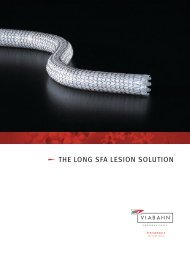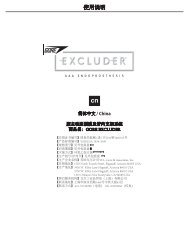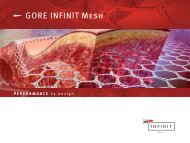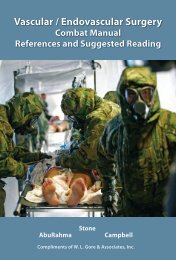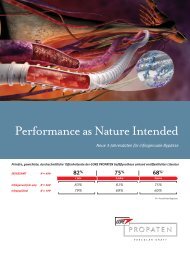Closing Remarks Spring 2013 - Gore Medical
Closing Remarks Spring 2013 - Gore Medical
Closing Remarks Spring 2013 - Gore Medical
You also want an ePaper? Increase the reach of your titles
YUMPU automatically turns print PDFs into web optimized ePapers that Google loves.
<strong>Closing</strong> <strong>Remarks</strong><br />
In This<br />
ISSUE<br />
• CASE STUDY<br />
Placement of a Large GORE ®<br />
HELEX ® Septal Occluder in a<br />
Patient with Deficient Aortic<br />
Rim and Atrial Septal Aneurysm<br />
• FEATURED TOPIC<br />
<strong>Gore</strong> Fine Filtration Technology:<br />
Meeting the Demands of the<br />
Electronics Industry<br />
• IN THE NEWS<br />
– In Pursuit of the PFO<br />
Closure Indication<br />
• UPCOMING EVENTS<br />
– The Society for Cardiovascular<br />
Angiography and Interventions<br />
(SCAI <strong>2013</strong>)<br />
– Congenital and Structural<br />
Interventions (CSI <strong>2013</strong>)<br />
PERFORMANCE by design<br />
C A S E S T U D Y<br />
Placement of a Large GORE ® HELEX ®<br />
Septal Occluder in a Patient with Deficient<br />
Aortic Rim and Atrial Septal Aneurysm<br />
Louai Razzouk, MD, MPH<br />
Muhamed Saric, MD, PhD<br />
James N Slater, MD<br />
Leon H. Charney Division of Cardiology, Department of Medicine<br />
New York University Langone <strong>Medical</strong> Center, New York, USA<br />
A 55-year-old woman with a history of type II diabetes mellitus, hypertension,<br />
severe chronic obstructive pulmonary disease and atrial fibrillation on<br />
anticoagulation presented with worsening dyspnea on exertion. The patient<br />
reported a limited exercise tolerance to less than half a city block, and was<br />
Continued on inside cover...<br />
goremedical.com/HELEX<br />
<strong>Spring</strong> <strong>2013</strong> • Issue XXII
...Case Study continued from cover<br />
Placement of a Large GORE ® HELEX ® Septal Occluder in a<br />
Patient with Deficient Aortic Rim and Atrial Septal Aneurysm<br />
referred for a possible percutaneous<br />
closure of a newly diagnosed secundum<br />
atrial septal defect (ASD) with a mobile<br />
atrial septal aneurysm seen on<br />
echocardiography (Figure 1, Video 1*).<br />
Her comorbidities precluded her from<br />
surgical repair of the ASD.<br />
Hemodynamic evaluation of the defect<br />
revealed a left-to-right shunt with a<br />
Q p<br />
:Q s<br />
of 2.4:1.0, with severe right atrial<br />
and right ventricular (RV) dilatation<br />
and paradoxical interventricular septal<br />
motion due to to RV volume overload.<br />
The contractility of the RV and left<br />
ventricle (LV) was normal, and there was<br />
moderate elevation in the pulmonary<br />
artery systolic pressure to 47 mmHg.<br />
Full evaluation of ASD morphology<br />
and size was subsequently performed<br />
on 2D and 3D transesophageal<br />
echocardiography (TEE). The ASD was<br />
ovoid in shape. Using multiplane<br />
reconstruction technique of 3D TEE,<br />
the defect was sized precisely; it<br />
measured 22 x 17 mm and had a minimal<br />
aortic rim (Figure 2). Attached to the<br />
superior and inferior rim of the defect,<br />
there was a mobile atrial septal<br />
aneurysm (Figure 3, Videos 2 and 3*).<br />
Of note, the coronary sinus was dilated,<br />
likely due to a persistent left superior<br />
vena cava.<br />
The ASD was crossed with a multipurpose<br />
catheter over a J-wire, and a stiff<br />
AMPLATZ Wire was positioned in the left<br />
upper pulmonary vein. A 25 mm sizing<br />
balloon was used to measure the size of<br />
the ASD, and stop-flow analysis revealed<br />
defect size of approximately 18 mm in<br />
diameter (Figure 4, Video 4*). Although<br />
the atrial septal aneurysm, attached to<br />
the rim of the ASD, was noted floating<br />
freely in the right atrium, the balloon<br />
passed without difficulty into the left<br />
atrium. Given the oblong shape of the<br />
ASD and the absence of aortic rim as<br />
shown on 3D TEE, the decision was made<br />
to perform ASD closure with a GORE ®<br />
HELEX ® Device in order to minimize the<br />
risk of erosion into the aortic wall.<br />
The largest GORE ® HELEX ® Septal<br />
Occluder (35 mm nominal diameter) was<br />
therefore chosen, and positioned with<br />
fluoroscopic and TEE guidance. After<br />
initial placement, there was significant<br />
residual left-to-right flow on color<br />
Doppler around the aortic rim. The device<br />
was then retrieved and repositioned<br />
more anteriorly. After repositioning the<br />
device, the ASD was well covered with<br />
only minimal residual left-to-right flow<br />
around the posterior portion of the<br />
device (Figure 5). Given the near-optimal<br />
result, the device was released (Figure 6).<br />
A transthoracic echocardiogram (TTE)<br />
performed the following day did not<br />
visualize any definitive evidence of<br />
residual right-to-left shunt after<br />
intravenous infusion of agitated saline<br />
at baseline or after Valsalva maneuver.
No residual left-to-right flow was visualized<br />
on TTE by color Doppler. Left and right<br />
ventricular functions were normal, and the<br />
right ventricle was still dilated. The patient<br />
was discharged on aspirin and clopidogrel<br />
daily for six months, with follow-up in our<br />
cardiology clinic.<br />
At six weeks follow-up, the patient<br />
reported a marked decrease in dyspnea<br />
on exertion, and an improvement in her<br />
exercise tolerance from one-half a city<br />
block to five city blocks.<br />
At eight weeks follow-up, TTE showed<br />
normal biventricular systolic function<br />
and normalization of the right ventricular<br />
size. 2D / 3D TEE demonstrated a<br />
well-seated GORE ® HELEX ® Device across<br />
the interatrial septum and along the<br />
aortic rim (Figure 7, Video 5*). There was<br />
no evidence of right-to-left shunting<br />
following intravenous infusion of<br />
agitated saline, and no color Doppler<br />
Figure 1 / Video 1*. Midesophageal 2D TEE image at the short<br />
axis of the aortic valve reveals a large secundum ASD (asterisk)<br />
and a mobile atrial septal aneurysm (arrow). Note that ASD<br />
lacks an aortic rim. AV, aortic valve; LA, left atrium; PV, pulmonic<br />
valve; RA, right atrium, RV, right ventricle; TV, tricuspid valve.<br />
Video 1 corresponds to Figure 1.<br />
evidence of left-to-right shunting.<br />
Continued on next page...
...Case Study continued from previous page<br />
Discussion<br />
While a large AMPLATZER ® Septal<br />
Occluder would have probably<br />
successfully closed the septal defect<br />
in this patient, the concern for distortion<br />
of the aortic root guided us towards<br />
a more compliant closure device.<br />
Reports of erosion of the AMPLATZER ®<br />
Septal Occluder into the aorta may have<br />
Figure 2. Multiplane reconstruction on 3D TEE<br />
demonstrates an ovoid ASD measuring 22 x 17 mm.<br />
occurred in patients with a deficient<br />
aortic rim 1 . Furthermore, an oversized<br />
AMPLATZER ® Septal Occluder may also<br />
increase the risk of erosion, as the<br />
device-to-unstretched ASD ratio has<br />
been noted to be significantly larger<br />
in patients with unfavorable outcomes.<br />
Even though the incidence of<br />
AMPLATZER ® Septal Occluder erosion<br />
into the aortic root is low (approximately<br />
1 in 1,000 cases), such a complication<br />
may often be avoided in patients with<br />
deficient rims with a use of a more<br />
Figure 3 / Videos 2 and 3*. 3D TEE image<br />
demonstrates the right atrial aspect of the ASD with<br />
an atrial septal aneurysm (asterisk) and minimal<br />
aortic rim (arrows). AV, aortic valve; SVC, superior<br />
vena cava. Video 2 corresponds to Figure 3. Video 3<br />
demonstrates the left atrial aspect of ASD.<br />
compliant ASD closure device.<br />
The large size of the defect in our<br />
patient was of concern to us, as it
approached the 2:1 sizing ratio<br />
limit of the GORE ® HELEX ® Device.<br />
The repositioning of the largest GORE ®<br />
HELEX ® Device available was required<br />
for successful closure of the defect.<br />
The risk of device embolization can<br />
increase with large defects and minimal<br />
rims. Interventional cardiologists thus<br />
face a challenge of choosing the optimal<br />
device with the smallest occluding size<br />
in order to minimize the risk of erosion,<br />
but also large enough to ensure stable<br />
placement to prevent embolization. Given<br />
its pliability, the GORE ® HELEX ® Device<br />
may be well suited for closure of large<br />
ASDs with deficient aortic rims.<br />
Figure 4 / Video 4*. Sizing<br />
balloon (asterisk) seen across<br />
the ASD on fluoroscopy (Panel<br />
A) and on 3D TEE (Panel B).<br />
LA, left atrium; LUPV, left<br />
upper pulmonary vein; MV,<br />
mitral valve; RA, right atrium;<br />
RUPV, right upper pulmonary<br />
vein. Video 4 corresponds to<br />
Figure 4 and demonstrates no<br />
flow around the balloon on<br />
color Doppler.<br />
References<br />
1. Amin Z, Hijazi ZM, Bass JL, Cheatham JP,<br />
Hellenbrand WE, Kleinman CS. Erosion<br />
of Amplatzer septal occluder device after<br />
closure of secundum atrial septal defects:<br />
review of registry of complications and<br />
recommendations to minimize future risk.<br />
Catheterization & Cardiovascular Interventions<br />
2004;63(4):496-502.<br />
Figure 5. GORE ® HELEX ® Septal Occluder (asterisk) being positioned in the ASD on fluoroscopy<br />
(Panel A) and on 3D TEE (Panel B). AV, aortic valve; LA, left atrium; RA, right atrium; SVC, superior<br />
vena cava.<br />
Continued on next page...
...Case Study continued from previous page<br />
* The video files referenced in these articles<br />
are available in our online version of the <strong>Closing</strong><br />
<strong>Remarks</strong> newsletter: www.goremedical.com/<br />
HELEX/library/newsletters<br />
Please refer to GORE ® HELEX ® Septal Occluder<br />
Instructions for Use at goremedical.com for<br />
a complete description of all indications,<br />
contradindications, warnings, precautions,<br />
and adverse events.<br />
Figure 6. GORE ® HELEX ® Septal Occluder (arrow) fully deployed on fluoroscopy (Panel A) and on<br />
2D TEE (Panel B). AV, aortic valve; LA, left atrium; RA, right atrium.<br />
This case study is not intended to express the<br />
views, opinions, or recommendations of the<br />
device manufacturer, W. L. <strong>Gore</strong> & Associates,<br />
rather the views, opinions, or recommendations<br />
expressed herein are exclusively the authors’ own.<br />
Figure 7 / Video 5*. 3D TEE appearance of<br />
GORE ® HELEX ® Septal Occluder (asterisk)<br />
from the right atrial (Panel A) and left atrial<br />
(Panel B) perspective. AV, aortic valve; LA,<br />
left atrium; RA, right atrium; SVC, superior<br />
vena cava. Video 5 corresponds to Figure<br />
7; it first reveals the right atrial aspect of<br />
the GORE ® HELEX ® Device, then it shows<br />
the cusps of the aortic valve and finally the<br />
left atrial aspect of the device.
Outcomes You Can Count On.<br />
Watch On-Demand! Webinar Review of<br />
FDA Circulatory System Devices Advisory Panel Meeting<br />
www.goremedical.com/HELEXWebinar<br />
Rest assured knowing your patient is implanted<br />
with a GORE ® HELEX ® Septal Occluder.<br />
High closure rates and low major adverse event rates<br />
demonstrated through clinical study data*<br />
No reported erosions**<br />
No reported late emergent surgical interventions**<br />
* Results from the Feasibility, Pivotal, Continued Access, and Post-Approval Studies<br />
demonstrate 98.3% closure rate and a Major Adverse Event rate < 5% at one year.<br />
Major Adverse Events were defined as any event requiring reintervention, readmission<br />
to the hospital, or resulted in permanent damage or deficit.<br />
** Data on file.
F E A T U R E D T O P I C<br />
<strong>Gore</strong> Fine Filtration Technology:<br />
Meeting the Demands of the Electronics Industry<br />
It sounds counter intuitive: a filter that<br />
can capture extremely fine particles at a<br />
high rate while also processing liquids<br />
at a very fast rate, but <strong>Gore</strong> has achieved<br />
this with its fine filtration technology,<br />
currently used in the manufacture of<br />
semiconductor materials for the<br />
electronics industry.<br />
Semiconductors are found in all modern<br />
electronic devices that use circuitry, for<br />
example, computers, cell phones, IPOD ®<br />
Mobile Devices, BLACKBERRY ® Devices<br />
and navigational systems. Because even<br />
extremely small particles can damage<br />
their performance, semiconductors<br />
require a clean manufacturing process,<br />
including the<br />
use of filtered, ultrapure water and<br />
high-purity chemicals. <strong>Gore</strong>’s filters<br />
retain particles from these liquids<br />
without slowing the rate of liquid flow<br />
through the filter.<br />
“Normally, filters cannot achieve both<br />
high particle retention rates and high<br />
flow rates; you have to sacrifice one for<br />
the other,” explains marketing associate<br />
Virginia Gatch. “By delivering both,<br />
our filters offer a level of performance<br />
completely unmatched in the industry.”<br />
To understand the difficulty of achieving<br />
simultaneously high flow and high<br />
retention rates, imagine sifting flour<br />
before baking a cake. To successfully<br />
remove the smallest of impurities, you<br />
would need a sifter with extremely tiny<br />
grates. But this would also slow the<br />
sifting process, because it would take<br />
longer for flour to flow through small<br />
openings than large ones. Of course,<br />
in this case, if an impurity falls through<br />
the cracks or if efficiency is reduced,<br />
the impact is minimal.<br />
But imagine removing microscopic<br />
particles from the liquids used in<br />
semiconductor manufacturing processes.<br />
If a particle gets through, it could greatly<br />
compromise the performance of the<br />
finished product. With one<br />
semiconductor wafer worth nearly half<br />
a million dollars, it is understandable<br />
why manufacturers want to retain the<br />
smallest particles possible and also<br />
maintain fast manufacturing rates. As<br />
business leader Kent Steeves, notes,<br />
“In the world of semiconductor<br />
manufacturing, yield is everything.”<br />
A Technology Breakthrough<br />
In 2007, <strong>Gore</strong> achieved a breakthrough<br />
with its fine filtration technology. For<br />
decades, the liquid microfiltration media<br />
business had sold ePTFE filter media to<br />
outside companies for use in their<br />
<strong>Gore</strong>’s filter cartridges, like the one pictured<br />
above, retain particles from the ultrapure water<br />
and high-purity chemicals used in semiconductor<br />
manufacturing. Also pictured above is a silicon<br />
wafer—the building block for semiconductor chips.<br />
Semiconductors are found in all modern electronic<br />
devices that use circuitry, such as computers and<br />
cell phones.<br />
filtration devices. But after creating a<br />
next generation material that offered<br />
both improved retention and flow<br />
rates, the business decided to begin<br />
manufacturing its own finished filters.<br />
“We already had the best media in the<br />
world, and we had a very successful<br />
business as a media supplier,” Kent says.<br />
“But our breakthrough in technology<br />
caused us to pause and investigate
whether we were truly understanding<br />
the value that we bring, and if we were<br />
adequately capturing the value.”<br />
Following the technology breakthrough<br />
and subsequent business model change,<br />
product specialist Dan Lash, worked with<br />
the team behind <strong>Gore</strong>’s first filter device<br />
to drive a key win with one of the world’s<br />
largest semiconductor chip<br />
manufacturers. Since then, the fine<br />
filtration business has continued to<br />
make inroads with other key customers<br />
based on its distinct technology.<br />
The business also continues to supply<br />
media to other filter makers, but, since<br />
2007, has only used new ePTFE materials<br />
in <strong>Gore</strong> filters. Dan explains, “We offer<br />
something truly unique. Our filters have<br />
greater porosity than competing options.<br />
This means we can fit more small pores in<br />
a given space, allowing us to achieve high<br />
flow rates without sacrificing retention.”<br />
the competition, but we do have better<br />
performance. And this is what our target<br />
market really values.”<br />
<strong>Gore</strong>’s filters can capture particles as<br />
small as 20 nanometers, or 20 billionths<br />
of a meter in diameter. And the business<br />
is developing technologies to meet the<br />
even tighter industry demands expected<br />
in the coming years. In addition to<br />
semiconductor manufacturing, <strong>Gore</strong>’s<br />
filters are used in the manufacture of<br />
LCDs (liquid crystal displays), LEDs<br />
(light-emitting diodes), solar cells and<br />
hard disk drives.<br />
“The requirements in these industries<br />
are getting tighter and tighter, and the<br />
demand for better performance is<br />
increasing. Our technology is able to<br />
meet these needs,” Dan says. “We also<br />
have better access now to equipment<br />
makers and end users, which helps us<br />
develop technologies that meet their<br />
most pressing needs.”<br />
Unparalleled Performance<br />
Soaring Su, an Asia-Pacific sales leader,<br />
says this has helped the business<br />
overcome many of the challenges<br />
associated with entering an already<br />
established market. “We don’t have<br />
as broad a product line or as much<br />
experience making finished filters as
I N T H E N E W S<br />
In Pursuit of the PFO Closure Indication<br />
Two doctors involved in the ongoing <strong>Gore</strong> REDUCE Clinical Study reflect on the meaning of the much-discussed results from<br />
St. Jude <strong>Medical</strong>’s RESPECT Study<br />
The cardiology community is still discussing the findings from St. Jude <strong>Medical</strong>’s RESPECT Study, which were<br />
presented last fall at the 2012 Transcatheter Cardiovascular Therapeutics (TCT) scientific symposium in Miami.<br />
The results — while not reaching statistical significance to demonstrate the superiority of device closure to<br />
medical therapy — offer support for further investigation of device closure’s potential benefit for patients with<br />
cryptogenic stroke and PFO.<br />
Seeking greater insight into the study’s findings and what they mean on the clinical side, industry publication<br />
Cardiac Interventions Today 1 recently spoke with Robert Sommer, MD of Columbia University <strong>Medical</strong> Center<br />
in New York, investigator for the <strong>Gore</strong> REDUCE Clinical Study; and John Rhodes, MD of Duke University <strong>Medical</strong><br />
Center in Durham, North Carolina, the US cardiologist principal investigator for the <strong>Gore</strong> REDUCE Clinical Study.<br />
In this interview excerpt, the doctors explain how results from the St. Jude study could potentially influence<br />
treatment of PFO for the prevention of recurrent stroke; they also address some criticisms of the data.<br />
What are the significant take-home points regarding the data from the RESPECT Study?<br />
Dr. Rhodes: I would point out that this is a well-done study with a large patient population, but<br />
in an environment with off-label use and other insurance-related issues that potentially make<br />
it difficult to enroll and make the enrollment period longer. I think knowing that, and what the<br />
outcomes were, it is a good study that gives us a lot of information about which direction to move<br />
toward regarding therapy for patients with cryptogenic stroke.<br />
What are the criticisms of the RESPECT data that need to be addressed?<br />
Dr. Sommer: Well, the RESPECT Study data in general are excellent. It was a very well-run study.<br />
The major issue for somebody reading these results would be that the intent-to-treat analysis led<br />
to a result in which a third of the patients who had a stroke in the closure arm never underwent<br />
closure. This obviously confounds the results of the study. But, from a statistical point of view,<br />
if that aspect of the trial is invalid because of unequal dropout in the two groups, and if the<br />
intent-to-treat analysis and per-protocol analyses are not valid either because you affect the<br />
randomization and there is potential bias introduced into the study, then potentially none of the<br />
outcomes are statistically significant.<br />
1. Cardiac Interventions Today. The RESPECT Trial. Robert Sommer, MD, and John Rhodes, MD, share their insights on the recently<br />
presented data and how this will influence clinical practice. Cardiac Interventions Today <strong>2013</strong>;7(1):34-37.
Dr. Rhodes: The other issue in the way that the RESPECT Study was designed is that it included<br />
patients in the medical arm who were on warfarin. I think if you’re randomizing warfarin as a<br />
therapy versus device closure, the real risk / benefit balance is going to be long-term risk of<br />
bleeding complications from warfarin rather than recurrent stroke on warfarin. If 25% of your<br />
medical arm is on warfarin, that 25% in the follow-up time period that they had may not have<br />
had an adverse event of recurrent stroke but would have a significant and well-understood risk<br />
of bleeding adverse events in the years to come. So, 25% of your medical arm may be less likely<br />
to have the endpoint of recurrent stroke compared to the aspirin or clopidogrel arm.<br />
To read more of the interview, access the complete article from Cardiac Interventions Today 1 .<br />
As Dr. Rhodes and Dr. Sommer pointed out in the article, results from the RESPECT Study showed significant<br />
promise for device therapy. Still, it is important to note that there is no device available in the US indicated for this<br />
therapy. These data continue to be digested by the physician community, investigators, as well as the FDA, and<br />
should be considered alongside the totality of evidence that has been generated to date.<br />
Meanwhile, the <strong>Gore</strong> REDUCE Clinical Study — the only remaining PFO Stroke Study in the US — continues to enroll<br />
patients. The study seeks to determine which option is better at reducing the risk of having another stroke: closing<br />
a patient’s PFO with the GORE ® Septal Occluder plus taking some antiplatelet medication, or taking antiplatelet<br />
medication alone without closing the PFO.<br />
As noted previously by the <strong>Gore</strong> REDUCE Clinical Study steering committee, <strong>Gore</strong>’s study shares many similarities<br />
with St. Jude <strong>Medical</strong>’s study in terms of enrollment criteria, such as exclusion of patients who had transient<br />
ischemic attacks or lacunar infarct syndrome.<br />
Furthermore, the <strong>Gore</strong> REDUCE Clinical Study should also benefit from stringent patient selection, consistency<br />
in the prescribed medical therapy across treatment arms, and the required neuroimaging of every patient at two<br />
years post randomization.<br />
<strong>Gore</strong> recently reported its best enrolling month in the history of the study, reaffirming the investigators'<br />
commitment to obtaining the answer to this important research question. <strong>Gore</strong> encourages physicians to<br />
continue to refer applicable patients to the <strong>Gore</strong> REDUCE Clinical Study sites for enrollment consideration.<br />
Find more details about the <strong>Gore</strong> REDUCE Clinical Study at www.clinical.goremedical.com/REDUCE.
U P C O M I N G E V E N T S<br />
Please Join Us…<br />
The Society for Cardiovascular Angiography and Interventions (SCAI <strong>2013</strong>)<br />
May 8 – 11, <strong>2013</strong> Orlando, Florida Booth #1101<br />
Congenital and Structural Interventions (CSI <strong>2013</strong>)<br />
June 27 – 29, <strong>2013</strong><br />
Frankfurt, Germany<br />
If you have a topic that you would like us to consider in a future issue of <strong>Closing</strong> <strong>Remarks</strong>,<br />
please contact your local <strong>Gore</strong> Sales Associate or e-mail <strong>Closing</strong><strong>Remarks</strong>@wlgore.com<br />
W. L. <strong>Gore</strong> & Associates, Inc.<br />
Flagstaff, AZ 86004<br />
+65.67332882 (Asia Pacific) 800.437.8181 (United States)<br />
00800.6334.4673 (Europe) 928.779.2771 (United States)<br />
goremedical.com<br />
INDICATIONS FOR USE IN THE US: The GORE ® HELEX ® Septal Occluder is a permanently implanted prosthesis indicated for the percutaneous,<br />
transcatheter closure of ostium secundum atrial septal defects (ASDs). INDICATIONS FOR USE UNDER CE MARK: The GORE ® HELEX ® Septal<br />
Occluder is a permanently implanted prosthesis indicated for the percutaneous, transcatheter closure of atrial septal defects (ASDs),such as<br />
ostium secundum and patent foramen ovale. Refer to Instructions for Use at goremedical.com for a complete description of all contraindications,<br />
warnings, precautions and adverse events.<br />
Products listed may not be available in all markets.<br />
GORE ® , HELEX ® , MEDICAL MASTERY, PERFORMANCE BY DESIGN, and designs are trademarks of W. L. <strong>Gore</strong> & Associates.<br />
AMPLATZ is a trademark of COOK ® <strong>Medical</strong>.<br />
AMPLATZER ® is a trademark of St. Jude <strong>Medical</strong>, Inc. and its related companies.<br />
BLACKBERRY ® is a trademark of Research in Motion.<br />
IPOD ® is a trademark of Apple Inc.<br />
© <strong>2013</strong> W. L. <strong>Gore</strong> & Associates, Inc. AS0958-EN1 MARCH <strong>2013</strong>




